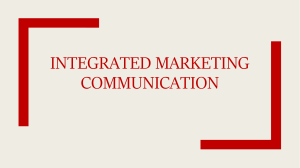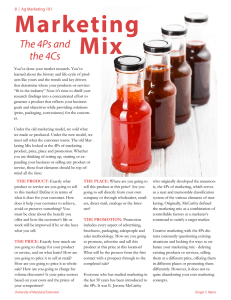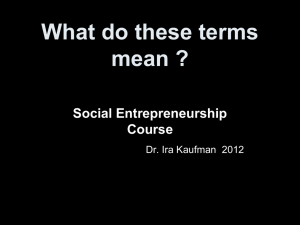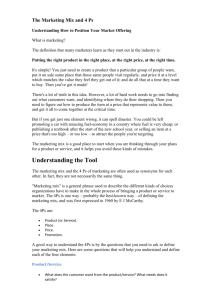4Ps of Marketing: Product, Price, Place, Promotion Explained
advertisement
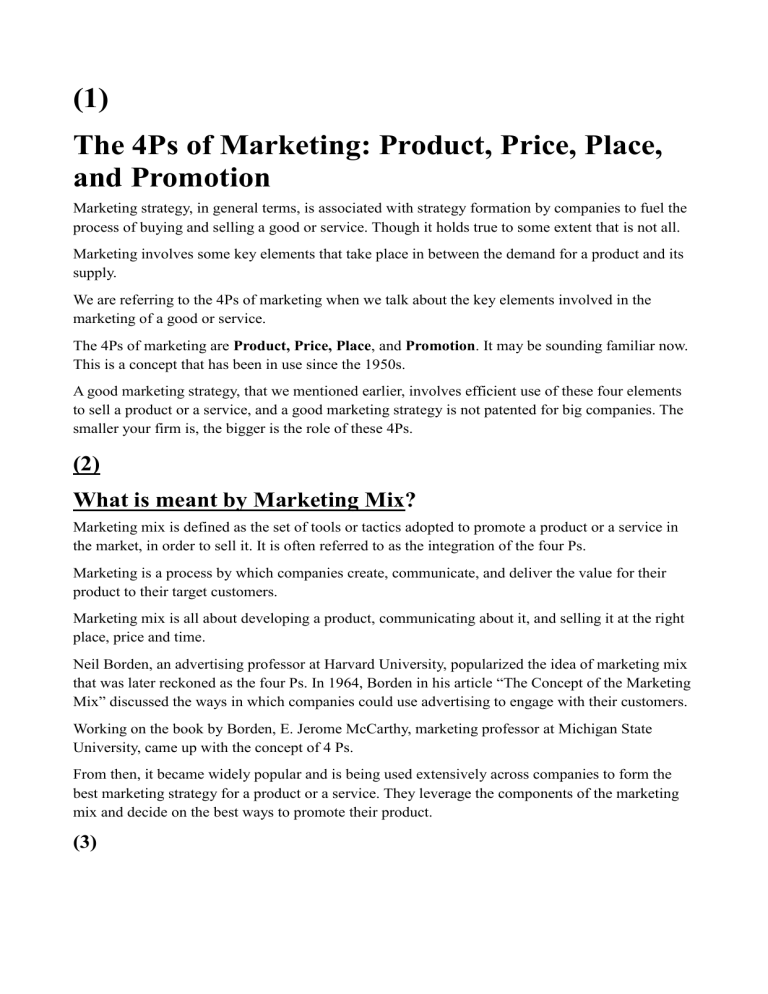
(1) The 4Ps of Marketing: Product, Price, Place, and Promotion Marketing strategy, in general terms, is associated with strategy formation by companies to fuel the process of buying and selling a good or service. Though it holds true to some extent that is not all. Marketing involves some key elements that take place in between the demand for a product and its supply. We are referring to the 4Ps of marketing when we talk about the key elements involved in the marketing of a good or service. The 4Ps of marketing are Product, Price, Place, and Promotion. It may be sounding familiar now. This is a concept that has been in use since the 1950s. A good marketing strategy, that we mentioned earlier, involves efficient use of these four elements to sell a product or a service, and a good marketing strategy is not patented for big companies. The smaller your firm is, the bigger is the role of these 4Ps. (2) What is meant by Marketing Mix? Marketing mix is defined as the set of tools or tactics adopted to promote a product or a service in the market, in order to sell it. It is often referred to as the integration of the four Ps. Marketing is a process by which companies create, communicate, and deliver the value for their product to their target customers. Marketing mix is all about developing a product, communicating about it, and selling it at the right place, price and time. Neil Borden, an advertising professor at Harvard University, popularized the idea of marketing mix that was later reckoned as the four Ps. In 1964, Borden in his article “The Concept of the Marketing Mix” discussed the ways in which companies could use advertising to engage with their customers. Working on the book by Borden, E. Jerome McCarthy, marketing professor at Michigan State University, came up with the concept of 4 Ps. From then, it became widely popular and is being used extensively across companies to form the best marketing strategy for a product or a service. They leverage the components of the marketing mix and decide on the best ways to promote their product. (3) 1. Product in Marketing Product in marketing mix refers to the good or service produced to serve the consumers of a company. A product can be tangible in the form of any finished good or intangible in the form of any service. “The first step in marketing is the manufacturing of a product”, this statement is debatable in itself as some may argue about the role of the R&D department of an organization. Nonetheless, it is true when we only talk about marketing mix. Every product goes through a certain lifecycle that has three stages: the growth phase, the maturity phase, and the sales decline phase. Marketers have to take good care of the fact that a product should not enter the last phase too quickly and even if it does, immediate action is sought to reinvent the product and stimulate more demand. It is the quality of a product or service that increases the brand value of a company. If there is no product there would be no company because we recognize a company by the services or the products they offer. A product is not always brand new. As we have mentioned above, when a product reaches the sales decline phase, it is needed to be reinvented. The R&D department of an organization goes among the customers to discover the reason behind the decline in demand for a product. The introduction of technology like Big Data Analytics has made the research work easy for the R&D department. One thing that should be brought to your attention is that companies also come up with new products that have an additional value as compared to the original product. (4) 2. Price in Marketing Price in marketing mix refers to the value we pay in exchange for the product and services offered by a company. Price is considered a vital element of the marketing mix because it dictates a company’s survival and profit. Pricing of a product plays an important role in determining the success of a company. Several factors like list price, competitor’s price, discount, terms of sales, etc., are taken into consideration before deciding on the price of a good or service. Even a little fluctuation in the price of a product can heavily impact its demand in the market. This sensitiveness of demand against price change is reckoned as the Price Elasticity of Demand (PED). The vice-versa also holds true. The price of a good is also determined after looking at the demand elasticity of the product. Companies should keep a check on the price of a product because an overpriced or underpriced product does not attract customers. (5) 3. Place in Marketing Place in marketing mix refers to the geographical location in which the company sells its products and provides its services. It is said that location is one of the most important parts of marketing strategy. Where you sell your products is important because the location must have your target customers. There is no sense in selling products to people who are not interested in your product or service. So, a firm should position and distribute its product in a place that is easily accessible to its potential buyers/customers. Place does not always refer to the store location. It also refers to the placing of products inside a store. Generally, companies like P&G demand their products to be prioritized in the planogram for a store. This would mean that their products should be placed in a manner where the products meet the eyelevel of the customer walking inside the store. Nowadays, when everything is shifting towards digital platforms, it becomes necessary for firms to place them on those digital platforms and leverage digital marketing. So in some cases, placement may also refer to the act of including a product on television shows, in films, or on web pages in order to seek attention for the product. This increased placement of more and more firms on digital platforms has led to a rise in ecommerce sector. (6) 4. Promotion in Marketing Promotion in the marketing mix refers to the communication that aims at promoting a product, activity, or a brand among the target customers; in order to drive sales, and involves both buyer and seller. Promotion is an essential component of the marketing mix because without communicating about a product, a company can not attract customers. It is also used to influence customers to buy a product or choose a particular brand. Promotional activities can involve spreading awareness about a product or the brand or also an activity. There are different tools that are leveraged for the purpose of promotion. The seven tools of Integrated Marketing Communication (IMC) are: 1. Advertising 2. Public Relations 3. Digital Marketing 4. Direct Selling 5. Personal Selling 6. Sales Promotion 7. Event Marketing One or more than one tool of IMC is used at a time to promote a product. For example, if a company is advertising for a product, it must ensure that the advertisement is backed by a report in the newspaper that talks about the product. (7) Importance of 4Ps of Marketing Promotes synergy The 4 Marketing P's once mixed properly generate coordination, offer a proper pitch to the product, becoming a powerful force together as opposed to individually. Brand loyalty and value With the focus primarily being on the needs and requirements of the consumers as well as ensuring their satisfaction, the product earns the loyalty and trust of the consumer through these 4Ps. Links the consumer and organization The features, place, and pricing of the product are settled with the objective of satisfying the customer's expectations, while the product's promotional aspects help in better positioning the product. As a result, a link is established between the consumer and the organization. Guides decision Our 4Ps play an integral role in guiding our decisions. For instance, if a product is based in a remote location, the promotion of the product will be carried out accordingly. Accordingly, the pricing of the product and its quality will be determined. Higher sales volume The more enhanced the customer satisfaction and the better the market scale, the more product sales would be boosted through the 4Ps. (8) The 7 P Model As the market has evolved over the years, the concepts also needed an upgrade. The concept of the 4 Ps has been in use since the 1950s, but it seemed to miss some key elements. The 7 P model talks about the three additional elements apart from the 4 Ps: People, Process, and Physical Evidence. The term People in marketing refers to the employees working for a company. They play an important role in the success of an organization as they are the ones who deliver the services to clients. It is important to manage this resource and People Analytics helps a lot in managing people. Process refers to the business process through which the service is provided to the clients. It becomes necessary to keep a regular check on the process so that any sort of mistake can be avoided. Examining the process means assessing aspects such as the sales funnel, payment systems, distribution procedures, and customer relationships management. Physical Evidence in marketing means to maintain evidence/proof that service or purchase took place and proof or confirmation of the existence of the brand. It can either be a receipt, or an invoice, or a brochure, for product delivery confirmation while for brand validation, it can be the company’s website, brand logo, business cards, etc. (9) Conclusion The 4 Ps of marketing have been in use since the 1950s. E. Jerome McCarthy came up with this concept and transformed the way marketing was done. With time, this concept too started to seem as outdated and forced marketers to include three more Ps namely, People, Process, and Physical Evidence. As Heraclitus said, “The only constant in life is change”. This 7 P model would also evolve further over the course of time.
